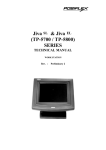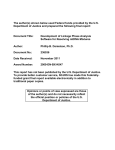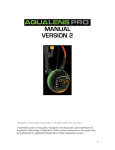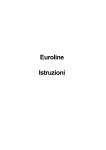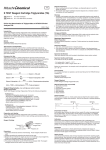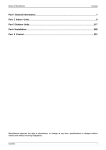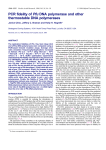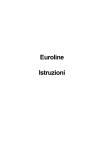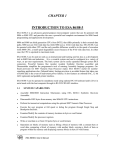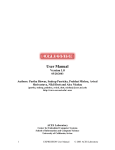Download PROT76834/AdvHF Kit(PT3139-1)
Transcript
Advantage®-HF PCR Kit User Manual (PT3139-1) Catalog #K1909-1, -y Storage conditions: –20°C FOR RESEARCH USE ONLY (PR76834) CLONTECH Laboratories, Inc. Table of Contents I. Introduction 3 II. List of Components 7 III. Additional Materials Required 8 IV. Advantage-HF PCR Kit Protocol 9 A. General Considerations 9 B. Control PCR Reactions 11 C. Recommended Cycling Parameters 12 D. Amplification of Longer Fragments with the Advantage Buffer 13 E. Recommendations for Electrophoresis 13 Troubleshooting Guide 14 VI. References 18 VII. Related Products 19 V. Notice to Purchaser A license under U.S. patents 4,683,202, 4,683,195, and 4,965,188 or their foreign counterparts, owned by HoffmannLa Roche and F. Hoffmann-La Roche Ltd. (“Roche”), has an up-front fee component and a running-royalty component. The purchase price of this product includes limited, non-transferable rights under the running-royalty component to use only this amount of the product to practice the Polymerase Chain Reaction (“PCR”) and related products described in said patents solely for the research and development activities of the purchaser when this product is used in conjunction with a thermal cycler whose use is covered by the up-front fee component. Rights to the up-front fee component must be obtained by the end-user in order to have a complete license. These rights under the up-front fee component may be purchased from Perkin-Elmer or obtained by purchasing an authorized thermal cycler. No right to perform or offer commercial services of any kind using PCR, including without limitation reporting the results of purchaser’s activity for a fee or other commercial consideration, is hereby granted by implication or estoppel. Further information on purchasing licenses to practice the PCR process may be obtained by contacting the Director of Licensing at the Perkin-Elmer Corporation, 850 Lincoln Centre Drive, Foster City, CA 94404 or at Roche Molecular Systems, Inc., 1145 Atlantic Avenue, Alameda, CA 94501. This product is sold under licensing arrangements with F. Hoffmann-La Roche Ltd., Roche Molecular Systems, Inc., and the Perkin-Elmer Corporation. Advantage-HF cDNA Polymerase Mix is covered by U.S. Patent No. 5,436,149. Foreign patents pending. TaqStart Antibodies are licensed under U.S. Patent No. 5,338,671 and corresponding patents in other countries. page 2 Protocol # PT3139-1 Version # PR76834 Technical Support TEL:415-424-8222 or 800-662-CLON FAX: 415-424-1064 or 800-424-1350 CLONTECH Laboratories, Inc. I. Introduction The Advantage ®-HF (High-Fidelity) PCR Kit is a KlenTaq-based system designed to deliver Pfu-like fidelity in the amplification of cDNA or genomic templates. High fidelity and efficiency While Pfu polymerase is known for its exceptional fidelity, it suffers from suboptimal efficiency that can be problematic in many PCR applications. In contrast, the Advantage-HF PCR Kit offers Pfu-like fidelity combined with the efficiency required to amplify DNA fragments of up to 2.5 kb. These benefits are the result of reformulation of several components in CLONTECH’s Advantage PCR Enzyme Systems. The Advantage-HF Polymerase Mix combines KlenTaq (a 5'exonuclease-deficient variant of Taq polymerase) with a proofreading polymerase and TaqStartTM Antibody to provide a superior level of specificity. Advantage-HF thus combines the benefits of Pfu and the Advantage Enzyme System to deliver a high-fidelity enzyme system. The HF Advantage The accuracy of Advantage-HF is compared to other enzymes and enzyme mixes in Figure 1. Using a genetic assay that measures nucleotide misincorporation, Advantage-HF rivals Pfu in fidelity. This fidelity assay is based on amplification of an E. coli ribosomal protein gene (Mo et al., 1991). Mutations in this gene often confer streptomycin resistance on the host. Upon introduction of the amplified DNA into E. coli, the ratio of total transformants to streptomycin resistant Accuracy (total transformants/strepr transformants) 500 435 385 400 300 200 71 67 100 19 0 Taq Advantage Advantage HF Pfu Taq + Pwo Enzyme Figure 1. Comparison of fidelity of Advantage-HF and other PCR systems. The fidelity of Advantage-HF compares favorably with that of the Pfu enzyme and is significantly higher than that of other enzyme systems. Accuracy assay is based on 25 cycles of amplification (see text). TEL:415-424-8222 or 800-662-CLON FAX:415-424-1064 or 800-424-1350 Technical Support Protocol # PT3139-1 Version # PR76834 page 3 CLONTECH Laboratories, Inc. I. Introduction continued transformants provides a comparative measure of PCR fidelity. The fidelity of Advantage-HF was confirmed by sequencing (Table I). The high level of fidelity delivered by the Advantage-HF system increases confidence in sequence derived from PCR products and is beneficial in a variety of PCR applications, including expression studies of amplified full-length cDNAs, generation of cDNA libraries, RACE, and analysis of homologous genes amplified with degenerate primers. TABLE I. FIDELITY OF ADVANTAGE-HF BASED ON SEQUENCING DATA Error rate a (per 100,000 bp) 180 b 2.4 Enzyme Taq Advantage-HF a b determined with individual clones after 25 PCR cycles agrees with published data (Ling et al. , 1991; Cariello et al., 1991) High-fidelity amplification of cDNA and Genomic templates Advantage-HF was used to amplify several cDNA templates of different lengths (Figure 2). Although amplification of the longest template yielded a reduced amount of product (Lane 6), this amplified product contains a higher percentage of accurate copies—nearly 6-fold higher than Advantage, and 20-fold higher than Taq, according to Figure 1. M 1 2 3 4 5 6 kb 4.42.0- 0.56- Figure 2. Advantage-HF amplification of cDNA fragments. Several fragments were amplified from Human Placenta cDNA under standard (Lanes 1, 3 & 5) and high-fidelity PCR conditions (AdvantageHF; Lanes 2, 4 & 6). M: λ/Hind III DNA size markers. Lanes 1 & 2: 0.5-kb fragment of glycerol 3phosphate dehydrogenase gene. Lanes 3 & 4: 1.3-kb fragment of transferrin receptor gene. Lanes 5 & 6: 2.5-kb fragment of lactoferrin gene. Cycling parameters: 30 sec at 94oC; 30 x (30 sec at 94 oC, 5 min at 68 oC); 5 min at 68 oC. page 4 Protocol # PT3139-1 Version # PR76834 Technical Support TEL:415-424-8222 or 800-662-CLON FAX: 415-424-1064 or 800-424-1350 CLONTECH Laboratories, Inc. I. Introduction continued The Advantage-HF Kit ensures high-fidelity amplification of genomic as well as cDNA templates. In Figure 3, the Advantage HF Kit was used to amplify a 2.1-kb fragment of the bovine pancreas trypsin inhibitor gene from different amounts of total calf thymus DNA. The fragment was efficiently amplified from as little as 25 ng of genomic DNA (Lane 4). Two reaction buffers are included in the Advantage-HF Kit: the HF Buffer and the original cDNA Buffer. Use of the HF buffer delivers the highest possible fidelity, as represented in Figure 1. Fragments of up to ~2.5 kb can be amplified under these conditions. To amplify longer fragments, some of the increase in fidelity can be sacrificed to improve elongation efficiency by combining the HF and cDNA buffers in varying proportions. Figure 4, Panel A shows the fidelity resulting from the use of varying percentages of the HF Buffer (see p. 3 for description of assay). Panel B demonstrates amplification of a 6.0-kb cDNA fragment using the indicated concentrations of HF Buffer. In this example, the fragment is successfully amplified in 80% HF Buffer, conditions allowing a ~3fold increase in fidelity over the cDNA buffer. Optimal conditions for the amplification of other fragments should be determined individually. TEL:415-424-8222 or 800-662-CLON FAX:415-424-1064 or 800-424-1350 ng: 1 2 3 4 5 100 75 50 25 0 Figure 3. Advantage-HF amplification from genomic DNA. The indicated amounts of calf thymus DNA were used to amplify a 2.1-kb fragment of the bovine pancreas trypsin inhibitor gene. M: λ/Hind III DNA size markers. Cycling parameters are the same as in Figure 2. A 2.0 1.5 Mutants (%) Increase elongation efficiency for longer fragments M 1.0 0.5 0 HF Buffer %: 0 20 40 60 80 100 B 4.4- 2.0- Figure 4. The effect of HF Buffer concentration on PCR fidelity (A) and amplification (B) of a 6.0-kb cDNA fragment from Human Placenta cDNA. Size markers are λ/ Hind III DNA. Technical Support Protocol # PT3139-1 Version # PR76834 page 5 CLONTECH Laboratories, Inc. I. Introduction continued Automatic hot start with TaqStart Antibodies Advantage-HF provides hot start PCR by including TaqStartTM Antibody in the polymerase mix, eliminating the need for additional pipetting or handling steps. "Hot start" refers to any method for assembling PCR reactions that keeps one or more of the reaction components physically or functionally separate from the rest of the components prior to the onset of thermal cycling. This prevents background due to low-level DNA synthesis from nonspecifically primed sites prior to the onset of thermal cycling. The advantages of hot start PCR have been demonstrated in many different applications. However, only CLONTECH's Advantage Polymerase Mixes provide automatic hot start. TaqStart is a neutralizing monoclonal antibody directed against Taq DNA polymerase. TaqStart recognizes both native Taq and N-terminal deletions such as KlenTaq-1. When premixed with the appropriate polymerase, the antibody blocks polymerase activity during the set-up of the PCR reactions at ambient temperatures. Polymerase activity is restored at the onset of thermal cycling because the antibody is denatured by temperatures greater than 60°C. The loss of inhibition is complete and irreversible, so the polymerase regains its full enzymatic activity for PCR. TaqStart-mediated hot start PCR has been shown to significantly improve the efficiency and specificity of DNA amplifications (Kellogg et al ., 1994; CLONTECHniques, April 1994). Antibody-mediated hot start with TaqStart has been proven to be at least as effective as manual hot start (d'Aquila et al., 1991) or wax-bead-mediated hot start (Chou et al., 1991). In particular, TaqStart reduces or eliminates nonspecific amplification products and primer-dimer artifacts. In some cases, specific products can only be obtained by using TaqStart. A PCR system for every application The Advantage cDNA and Genomic PCR Kits, containing the Advantage cDNA and Genomic Polymerase Mixes, respectively, are designed for high-efficiency, long-distance PCR amplification and are the foundation of the Advantage PCR Enzyme Systems (CLONTECHniques, July 1995; Barnes, 1994). These versatile kits are designed for high-performance amplification in the vast majority of PCR applications (including all of our PCR-based kits) and have firmly established the benefits of PCR enzyme mixes containing hot start antibodies. Our other Advantage-based kits have been developed for certain specialized applications. The Advantage-GC cDNA and Genomic PCR Kits and Mixes (CLONTECHniques, January 1997) combine the high efficiency of the Advantage system with a novel reagent, GC-MeltTM, and an optimized buffer containing DMSO to permit amplification of problematic GC-rich templates (up to 90% GC). As the newest addition to the Advantage line, Advantage-HF allows a new level of fidelity, balanced by the efficiency that is characteristic of Advantage. page 6 Protocol # PT3139-1 Version # PR76834 Technical Support TEL:415-424-8222 or 800-662-CLON FAX: 415-424-1064 or 800-424-1350 CLONTECH Laboratories, Inc. II. List of Components Advantage-HF PCR Kit (#K1909-1[100 rxns], 1909-y [10 rxns]) Store all components at –20°C. Enough reagents are supplied for 100 PCR reactions of 50 µl each. 10 rxns 100 rxns • 10 µl 100 µl 50X Advantage-HF Polymerase Mix Includes KlenTaq-1 DNA polymerase and TaqStart Antibody (1.1 µg/µl) in the following storage buffer. Concentration 1X in 50X Component Concentration 50 % Glycerol 1.0 % 40 mM Tris-HCl (pH 7.5) 0.8 mM 50 mM KCl 1.0 mM 25 mM (NH4)2SO4 0.5 mM 1 mM EDTA 20 µM 5.0 mM β-mercaptoethanol 0.1 mM 0.25 % Thesit 0.005 % Deep VentRTM is a minor component of the Advantage-HF Polymerase Mix. • • • • • 60 µl 60 µl 60 µl 400 µl 10 µl • 10 µl 600 µl 600 µl 600 µl 4 ml 100 µl 10X HF PCR reaction buffer 10X cDNA PCR reaction buffer 10X HF dNTP mix Purified Water (Millipore-purified) Control DNA template λ DNA (0.2 ng/µl) 40 µl Control primer mix (10 µM each) The sequences are: 5' primer 5'–TTGGTTGATCGTGGTGCAGAGAACGTTG–3' 3' primer 5'–GAGAAGGTCACGAATGAACCAGGCGATAA–3' TEL:415-424-8222 or 800-662-CLON FAX:415-424-1064 or 800-424-1350 Technical Support Protocol # PT3139-1 Version # PR76834 page 7 CLONTECH Laboratories, Inc. III. Additional Materials Required The following reagents are required but not supplied. • Mineral oil (We recommend Sigma® Cat. #M-3516.) • 0.5-ml PCR reaction tubes (We recommend Perkin-Elmer GeneAmpTM 0.5-ml reaction tubes [Cat. #N801-0737].) • Thermal cycler (Perkin-Elmer DNA Thermal Cycler 480, 9600, or equivalent) • Dedicated pipettors (1–2-µl, 1–10-µl, 1–20-µl, 20–200-µl, 200–1000-µl) • PCR pipette tips suitable for the above pipettors and equipped with aerosol-barrier filters. Do not autoclave pipette tips. • DNA size markers (See Section IV.D) • 5X Stop/loading buffer (Sambrook et al. [1989] provides several recipes.) page 8 Protocol # PT3139-1 Version # PR76834 Technical Support TEL:415-424-8222 or 800-662-CLON FAX: 415-424-1064 or 800-424-1350 CLONTECH Laboratories, Inc. IV. Advantage-HF PCR Kit Protocol PLEASE READ ENTIRE PROTOCOL BEFORE STARTING. A. General Considerations 1. Thermal cycler The guidelines for cycling parameters in this protocol have been developed for a Perkin-Elmer DNA Thermal Cycler 480 or 9600 and Perkin-Elmer GeneAmp 0.5-ml PCR reaction tubes. Newer cyclers may allow for shorter cycle times and eliminate the need to use oil. The optimal cycling parameters may vary with different templates, primers, experimental protocols, tubes, and thermal cyclers. Refer to the Troubleshooting Guide (Section V) for suggestions on optimizing PCR conditions. 2. Primer design Primer design is the single largest variable in PCR applications and the single most important factor in determining the success or failure of PCR reactions. Always check and recheck your primer design before constructing or ordering primers. CLONTECH offers PRIMER PREMIER (#V1072-1, V1079-1), powerful, easy-to-use software that ensures optimal primer design. Length and G/C content: The Advantage-HF PCR Kit can be used in a wide variety of PCR applications, and the constraints on primer design will vary from one application to the next. In general, however, primers should have a Tm of at least 70°C to achieve optimal results in a two-step cycling program with a 68°C annealing/extension step. Therefore, whenever possible, primers should be at least 22 nucleotides (nt) long (25–30-mers are preferred) and have a GC content of 45–60%. 3. Template quality Because of the exponential nature of PCR amplification, many conventional PCR applications work well with templates of average or even low quality. However, the longer the target, the more important template quality becomes. This is because the number of unnicked, fulllength targets decreases as the target length increases, so poor quality DNA will have very few large, unnicked targets. Furthermore, some depurination occurs when DNA is denatured during thermal cycling, and this can lead to strand scission. Therefore, it is particularly important to prepare high-quality, high molecular weight DNA when amplifying large targets. Template quality is also important when the highest possible sensitivity is needed. Furthermore, in cDNA applications such as RACE and other RT-PCR protocols, incomplete reverse transcription can lead to an absence of product, shorter than full-length products, or smearing. For 5' and 3' RACE and general PCR from cDNA, you can ensure the quality of your cDNA by using Marathon-Ready cDNA from CLONTECH. TEL:415-424-8222 or 800-662-CLON FAX:415-424-1064 or 800-424-1350 Technical Support Protocol # PT3139-1 Version # PR76834 page 9 CLONTECH Laboratories, Inc. IV. Advantage-HF PCR Kit continued 4. Good PCR practices a. Prepare reactions with dedicated pipettors in a dedicated work space Due to the tremendous amplification power of PCR, minute amounts of contaminating DNA can produce nonspecific amplification; in some instances, contaminants can cause DNA bands even in the absence of added template DNA. We recommend that you set up your PCR reactions in a dedicated lab area or noncirculating containment hood and use dedicated pipettors, PCR pipette tips with hydrophobic filters, and dedicated solutions. Perform postPCR analysis in a separate area with a separate set of pipettors. b. Pipetting Because of the small volumes used in PCR experiments and the potential for tube-to-tube variation, careful pipetting technique is extremely important. Always be sure that no extra solution is on the outside of the pipette tip before transfer. When adding solution to a tube, immerse the tip into the reaction mixture, deliver the solution, and rinse the pipette tip by pipetting up and down several times. c. Use a Master Mix Using a Master Mix greatly reduces tube-to-tube variation. Therefore, use a Master Mix whenever you set up multiple PCR reactions. If multiple templates are being tested with the same primers, include the primers in the Master Mix. If one template is being tested with multiple primer sets, include the template in the Master Mix. For several sets of parallel samples, assemble multiple master mixes (e.g., each with a different set of primers). The Master Mix should be thoroughly mixed before use (i.e., vortexed without bubbling). d. Include positive and negative controls (i.e., H2O instead of DNA template) 5. Touchdown PCR We have found that "touchdown" PCR significantly improves the specificity of many PCR reactions in a wide variety of applications (Section V.B.; Don et al., 1991; Roux, 1995). Briefly, touchdown PCR involves using an annealing/extension temperature that is several degrees (typically 3–10°C) higher than the Tm of the primers during the initial PCR cycles (typically 5–10). The annealing/extension temperature is then reduced to the primer Tm for the remaining PCR cycles. 6. TaqStart Antibody provides automatic hot start PCR Do not use a manual hot start or wax-bead-based hot start when using Advantage-HF. As discussed in the Introduction, hot start is automatic with Advantage-HF because the enzyme mix already contains TaqStart Antibody. page 10 Protocol # PT3139-1 Version # PR76834 Technical Support TEL:415-424-8222 or 800-662-CLON FAX: 415-424-1064 or 800-424-1350 CLONTECH Laboratories, Inc. IV. Advantage-HF PCR Kit continued 7. Use of additives TaqStart Antibody binds KlenTaq-1 DNA polymerase with high affinity under the conditions described in this protocol. The addition of 2–5% DMSO will not interfere with TaqStart function and may improve results in some instances (see Section V.A.). However, the addition of formamide or other cosolvents may disrupt TaqStart function. Furthermore, excessive glycerol, solutes (e.g., salts), pH extremes, or other deviations from the recommended reaction conditions may reduce the effectiveness of the antibody and/or DNA polymerases. B. Control PCR Reactions The following PCR reactions can be performed in parallel with your experiments as controls to ensure that the Advantage-HF Kit is working properly. A positive control template and primers are provided in the kit. 1. Place all components on ice and allow to thaw completely. Mix each component thoroughly before use. 2. Combine the following reagents in a 0.5-ml PCR tube. Positive Negative Control Control 32 µl 37 µl Purified H2O 5 µl 5 µl 10X HF PCR reaction buffer 5 µl --Control DNA template (~0.2 ng/µl) 2 µl 2 µl Control primer mix (10 µM ea.) 5 µl 5 µl 10X HF dNTP mix 1 µl 1 µl 50X Advantage-HF Polymerase Mix 50 µl 50 µl Total 3. Mix well and spin the tube briefly to collect all the liquid in the bottom of the tube. 4. Add 1–2 drops of mineral oil to prevent evaporation during cycling and cap firmly. A good "capping" of mineral oil should have a well-defined meniscus between the two phases. 5. Commence thermal cycling. If using a Perkin-Elmer DNA Thermal Cycler Model 480 or 9600, use the parameters described in Section C below. 20–22 cycles with a 4-min annealing/extension time is sufficient for amplification of the positive control template provided in the kit. 6. Transfer a 5-µl sample of your PCR reaction to a fresh tube and add 1 µl of 5X stop/loading buffer. Analyze your sample(s), along with suitable DNA size markers, by electrophoresis on a 0.8–1.2 % agarose/ ethidium bromide gel. Expected results: If you are using the positive control reagents provided in the kit, the reaction should produce a single major band of 2 kb. No bands should be generated in the negative (i.e., no DNA template) control. TEL:415-424-8222 or 800-662-CLON FAX:415-424-1064 or 800-424-1350 Technical Support Protocol # PT3139-1 Version # PR76834 page 11 CLONTECH Laboratories, Inc. IV. Advantage-HF PCR Kit continued C. Recommended Cycling Parameters Use the following guidelines when setting up your initial experiments with the Advantage-HF Polymerase Mix. These are general guidelines—the optimal parameters may vary with different thermal cyclers and will depend on your particular primers and templates, and on other experimental variables. Note: When using the Advantage-HF Kit with products such as CLONTECH's MarathonTM cDNA Amplification Kit, Marathon-ReadyTM cDNAs, or the DeltaTM Differential Display, use the parameters recommended in the protocol for that kit. Cycle Parameters (PE 480) • 94°C for 1 min • 25–35 cycles a 94°C 30 sec b 68°C 4 min c • 68°C for 3 min d • Soak at 15°C a b c d page 12 (PE 9600) • 94°C for 15 sec • 25–35 cycles a 94°C 5–15 sec 68°C 4 min c • 68°C for 3 min d • Soak at 15°C b 25 cycles for multiple-copy genes or medium-to-high abundance cDNAs; 30–35 cycles for single- or low-copy-number genes or rare cDNAs. For most applications, we prefer two-step cycles (denaturation at T1 followed by annealing and extension at T2) over three-step cycles (denaturation at T1 followed by annealing at T2 followed by extension at T3 ). Three-step cycles will be necessary when the Tm of the primers is less than 60–65°C and in certain special protocols (such as Delta Differential Display). Use the shortest possible denaturation time. Exposure of DNA to high temperatures causes some depurination of single-stranded DNA during denaturation, which eventually leads to strand scission. High temperature also leads to gradual loss of enzyme activity. Use the highest possible annealing/extension temperature. See Note a. Shorter targets may be amplified using shorter extension times. Some researchers prefer to use an annealing/extension time equal to the expected target size plus two minutes. Optional: This final extension may reduce background in some cases. Protocol # PT3139-1 Version # PR76834 Technical Support TEL:415-424-8222 or 800-662-CLON FAX: 415-424-1064 or 800-424-1350 CLONTECH Laboratories, Inc. IV. Advantage-HF PCR Kit continued D. Amplification of Longer Fragments with the Advantage Buffer The Advantage HF Kit is provided with two buffers—the HF Buffer and the standard cDNA Buffer. When used with the HF Buffer, this kit delivers the highest possible fidelity. Fragments of up to ~2.5 kb can be amplified under these conditions. To amplify longer fragments, some of the increase in fidelity can be sacrificed to improve elongation efficiency by combining the HF and cDNA buffers in varying proportions (see Figure 4). To amplify longer fragments, we recommend replacing the smallest amount of HF Buffer that allows satisfactory amplification. For example, the 6-kb fragment in Figure 4 can be amplified from a cDNA library in a 50-µl PCR reaction containing 4 µl of 10X HF Buffer (80% final) and 1 µl of 10X cDNA Buffer. Optimal conditions for the amplification of other fragments should be determined individually. We recommend initially trying HF Buffer concentrations in the 50–100% range for fragments up to 10 kb. E. Recommendations for Electrophoresis We recommend that you transfer a 5-µl sample of your PCR reaction to a fresh tube and add 1 µl of 5X stop/loading buffer. (The remaining 45 µl of the reaction mixture can be subjected to further cycling if you do not see a product.) Analyze your sample(s), along with suitable DNA size markers, by electrophoresis on a suitable agarose gel containing 0.1–0.5 µg/ml ethidium bromide. The percentage agarose and the DNA size markers you choose will depend on the expected range of insert sizes. You may wish to refer to the following general guidelines before assembling your gel. Recommendations for agarose gels: Expected Recommended insert size range % agarose 0.3–1.5 kb 1.5 0.5–10 kb 1.2 >5 kb 0.8 TEL:415-424-8222 or 800-662-CLON FAX:415-424-1064 or 800-424-1350 Technical Support Recommended DNA size markers φX174/Hae III 1-kb DNA ladder λ/Hin d III Protocol # PT3139-1 Version # PR76834 page 13 CLONTECH Laboratories, Inc. V. Troubleshooting Guide The following general guidelines apply to most PCR reactions. However, no attempt has been made to address troubleshooting for all of the many applications for which the Advantage-HF Kit can be used. When using the kit with another CLONTECH product, additional, application-specific troubleshooting information can be found in the relevant User Manual. A. No product observed PCR component Use a checklist when assembling reactions. Always missing or degraded perform a positive control to ensure that each component is functional. If the positive control does not work, repeat the positive control only. If the positive control still does not work, repeat again replacing individual components to identify the faulty reagent. Too few cycles Increase the number of cycles (3–5 additional cycles at a time). Annealing temp. Decrease the annealing temperature in increments too high of 2–4°C. Suboptimal primer Redesign your primer(s) after confirming the accudesign racy of the sequence information. If the original primer(s) was less than 22 nt long, try using a longer primer. If the original primer(s) had a GC content of less than 45%, try to design a primer with a GC content of 45–60%. Not enough Repeat PCR using a higher concentration of DNA template (after trying more cycles). Poor template Check template integrity by electrophoresis on a quality standard TBE-agarose gel. If necessary, repurify your template using methods that minimize shearing and nicking. Denaturation temp. Optimize denaturation temperature by decreasing or too high or low increasing it in 1°C increments. (A denaturation temperature that is too high can lead to degradation of the template, especially for long target sequences.) Denaturation time Optimize denaturation time by decreasing or increastoo long or too short ing it in 10-sec increments. (A denaturation time that is too long can lead to degradation of the template, especially for long target sequences.) Extension time too (Especially with longer templates) Increase the short extension time in 1-min increments. page 14 Protocol # PT3139-1 Version # PR76834 Technical Support TEL:415-424-8222 or 800-662-CLON FAX: 415-424-1064 or 800-424-1350 CLONTECH Laboratories, Inc. V. Troubleshooting Guide continued Too little enzyme Advantage-HF Polymerase Mix is 50X for most applications. Therefore, try to optimize the cycle parameters as described above before increasing the enzyme concentration. In rare cases, the yields can be improved by increasing the concentration of the enzyme mix. However, increasing the concentration >2X is likely to lead to higher background levels. 2+ [Mg ] is too low KlenTaq-1 DNA polymerase has a broader Mg2+ optimum than native Taq DNA polymerase (i.e., it performs well over a wider range of [Mg2+] with no loss of efficiency.) Therefore, as long as you use the buffers included in the kit, it is unlikely that a lack of product is due to problems with the Mg++ concentration. However, if the concentration of EDTA in the cDNA sample is more than 5 mM, this can reduce the effective concentration of Mg to below a minimum level. Increasing the concentration of Mg2+ can result in lower fidelity. [dNTPs] not optimal The Advantage-HF PCR Kit contains a carefully balanced mixture of the 4 dNTPs. Replacement of this mixture with a standard dNTP mix (200 µM each) may improve the DNA yield, but may also result in lower fidelity. Difficult target Some targets are inherently difficult to amplify. In most cases, this is due to unusually high GC content and/or secondary structure. The Advantage-GC Kits are recommended in these situations. B. Multiple products Too many cycles Annealing temp. too low Suboptimal primer design Reducing the cycle number may eliminate nonspecific bands. Increase the annealing/extension temperature in increments of 2–3°C. Redesign your primer(s) after confirming the accuracy of the sequence information. If the original primer(s) was less than 22 nt long, try using a longer primer. If the original primer(s) had a GC content of less than 45%, try to design a primer with a GC content of 45–60%. TEL:415-424-8222 or 800-662-CLON FAX:415-424-1064 or 800-424-1350 Technical Support Protocol # PT3139-1 Version # PR76834 page 15 CLONTECH Laboratories, Inc. V. Troubleshooting Guide continued Touchdown PCR needed Contamination "Touchdown" PCR significantly improves the specificity of many PCR reactions in various applications (Don et al., 1991; Roux, 1995). Touchdown PCR involves using an annealing/extension temperature that is several degrees higher than the Tm of the primers during the initial PCR cycles. The annealing/ extension temperature is then reduced to the primer Tm for the remaining PCR cycles. The change can be performed either in a single step or in increments over several cycles. See Section D below. C. Products are smeared Too many cycles Reduce the cycle number by 3–5 to see if nonspecific bands go away. Denaturation temp. Try increasing the denaturation temperature in incretoo low ments of 1°C. Extension time Decrease the extension time in 1–2-min increments. too long Poor template Check template integrity by electrophoresis on a dequality denaturing agarose gel. Repurify your template if necessary. Touchdown PCR See "Touchdown PCR needed" under previous needed section. Too much enzyme Advantage-HF Polymerase Mix is 50X for most applications; however, a 1X final concentration of the enzyme mix may be too high for some applications. If smearing is observed, first try optimizing the cycle parameters as described above, then try reducing the enzyme concentration to 0.5–0.2X. KlenTaq-1 DNA polymerase has a broader Mg2+ [Mg2+] is too high optimum than native Taq DNA polymerase (i.e., it performs well over a wider range of [Mg2+ ] with no loss of efficiency.) Therefore, as long as you have used the buffers supplied in the kit, it is unlikely that smearing is due to problems with the Mg 2+ concentration. Altering the concentration of Mg++ can result in lower fidelity. Too much template Try a lower concentration of DNA template in the PCR reaction. Contamination See Section D below. page 16 Protocol # PT3139-1 Version # PR76834 Technical Support TEL:415-424-8222 or 800-662-CLON FAX: 415-424-1064 or 800-424-1350 CLONTECH Laboratories, Inc. V. Troubleshooting Guide continued D. Dealing with contamination Contamination most often results in extra bands or smearing. It is important to include an H2O control (i.e., a control using H2O instead of the DNA template) in every PCR experiment to determine if the PCR reagents, pipettors or PCR reaction tubes are contaminated with previously amplified targets. If possible, set up the PCR reaction and perform the post-PCR analysis in separate laboratory areas with separate sets of pipettors. Laboratory benches and pipettor shafts can be decontaminated by depurination. Wipe surfaces with 1N HCl followed by 1N NaOH. Then neutralize with a neutral buffer (e.g., Tris or PBS) and rinse with H2O. It is advisable to use one of the commercially available aerosol-free pipette tips. There is an enzymatic method for destroying PCR product carryover (Longo et al., 1990). It involves incorporation of dUTP into the PCR products and subsequent hydrolysis with uracil-N-glycosylase (UNG). When performing PCR directly on phage plaques or bacterial colonies, failure to isolate single plaques or colonies will also produce multiple bands. TEL:415-424-8222 or 800-662-CLON FAX:415-424-1064 or 800-424-1350 Technical Support Protocol # PT3139-1 Version # PR76834 page 17 CLONTECH Laboratories, Inc. VI. References Advantage-GC PCR Kits (January 1997) CLONTECHniques XII(1):2–3. Barnes, W. M. (1994) PCR amplification of up to 35-kb DNA with high fidelity and high yield from λ bacteriophage templates. Proc. Natl. Acad. Sci. USA 91:2216–2220. Cariello, N. F., Swenberg, J. A. & Skopek, T. R. (1991) Fidelity of Thermococcus litoralis DNA polymerase (Vent) in PCR determined by denaturing gradient gel electrophoresis. Nucleic Acids Res. 19(15):4193–4198. Cheng, S., Fockler, C., Barnes, W. M. & Higuchi, R. (1994) Effective amplification of long targets from cloned inserts and human genomic DNA. Proc. Natl. Acad. Sci. USA 91:5695–5699. Chou, Q., Russell, M., Birch, D., Raymond, J. & Bloch, W. (1992) Prevention of pre-PCR mispriming and primer dimerization improves low-copy-number amplifications. Nucleic Acids Res. 20:1717– 1723. d'Aquila, R. T., Bechtel, L. J., Videler, J. A., Eron, J. J., Gorczyca, P. & Kaplan, J. C. (1991) Maximizing sensitivity and specificity of PCR by preamplification heating. Nucleic Acids Res. 19:3749. Don, R. H., Cox, P. T., Wainwright, B. J., Baker, K. & Mattick, J. S. (1991) 'Touchdown' PCR to circumvent spurious priming during gene amplification. Nucleic Acids Res. 19:4008. Frey, B. & Suppmann, B. (1995) Demonstration of the ExpandTM PCR system's greater fidelity and higher yields with a lacI-based PCR fidelity assay. Biochemica 2:8–9. Kellogg, D. E., Rybalkin, I., Chen, S., Mukhamedova, N., Vlasik, T., Siebert, P. & Chenchik, A. (1994) TaqStart Antibody: Hotstart PCR facilitated by a neutralizing monoclonal antibody directed against Taq DNA polymerase. BioTechniques 16:1134–1137. Ling, L. L., Keohavong, P., Dias, C. & Thilly, W. G. (1991) Optimization of the polymerase chain reaction with regard to fidelity: modified T7, Taq, and Vent DNA polymerases. PCR Methods Appl. 1:63–69. Longo, M. C., Berninger, M. S. & Hartley, J. L. (1990) Use of uracil DNA glycosylase to control carryover contamination in polymerase chain reactions. Gene 93:3749. Mo, J. Y., Maki, H. & Sekiguchi, M. (1991) Mutational specificity of the dnaE173 mutator associated with a defect in the catalytic subunit of DNA polymerase III of Escherichia coli. J. Mol. Biol. 222:925– 936. Nelson, K., Brannan, J. & Kretz, K. (1995) The fidelity of TaqPlusTM DNA Polymerase in PCR. Strategies Mol. Biol. 8:24–25. Roux, K. H. (1995) Optimization and troubleshooting in PCR. PCR Methods Appl . 4:5185–5194. Sambrook, J., Fritsch, E. F. & Maniatis, T. (1989) Molecular Cloning: A Laboratory Manual, Second Edition (Cold Spring Harbor Laboratory, Cold Spring Harbor, NY). page 18 Protocol # PT3139-1 Version # PR76834 Technical Support TEL:415-424-8222 or 800-662-CLON FAX: 415-424-1064 or 800-424-1350 CLONTECH Laboratories, Inc. VII. Related Products • • • • • • • • • Product Cat. # Advantage® cDNA PCR Kit Advantage® cDNA Polymerase Mix Advantage® Genomic PCR Kit Advantage® Genomic Polymerase Mix Advantage®-GC cDNA PCR Kit Advantage®-GC cDNA Polymerase Mix Advantage®-GC Genomic PCR Kit Advantage®-GC Genomic Polymerase Mix Advantage® UltraPure dNTPs #K1905-1, -y #8417-1 #K1906-1, -y #8418-1 #K1907-1, -y #8419-1 #K1908-1, -y #8420-1 (many) Other Related Products • • • • TaqStartTM Antibody TthStartTM Antibody PRIMER PREMIER Poly A+ RNA #5400-1, -2 #5401-1 many many • • Multiple Tissue Northern (MTNTM) Blots UltraPure PCR Deoxynucleotide Mix many #4700-1 TEL:415-424-8222 or 800-662-CLON FAX:415-424-1064 or 800-424-1350 Technical Support Protocol # PT3139-1 Version # PR76834 page 19 Advantage®, Advantage®-GC, Advantage ®-HF, DeltaTM, Marathon-Ready TM, TaqStartTM , and TthStartTM are trademarks of CLONTECH Laboratories, Inc. GeneAmpTM is a trademark of Hoffmann-La Roche, Inc. Deep VentRTM is a trademark of New England Biolabs, Inc. © 1997, CLONTECH Laboratories, Inc. All rights reserved.






















